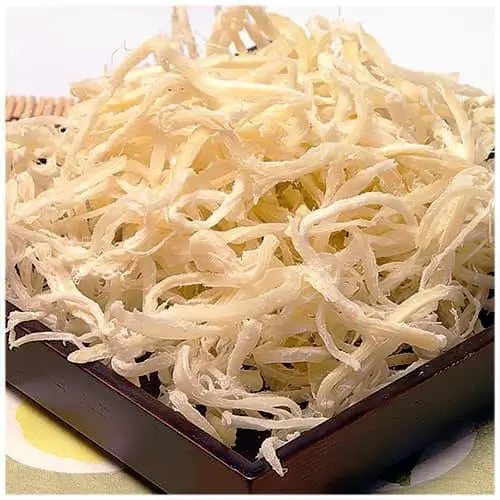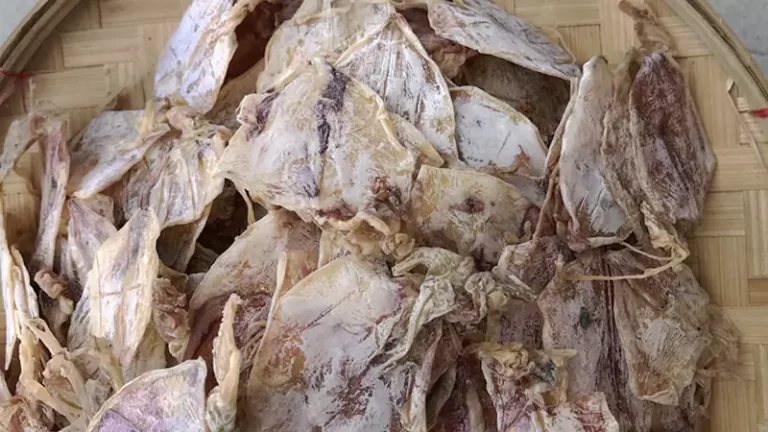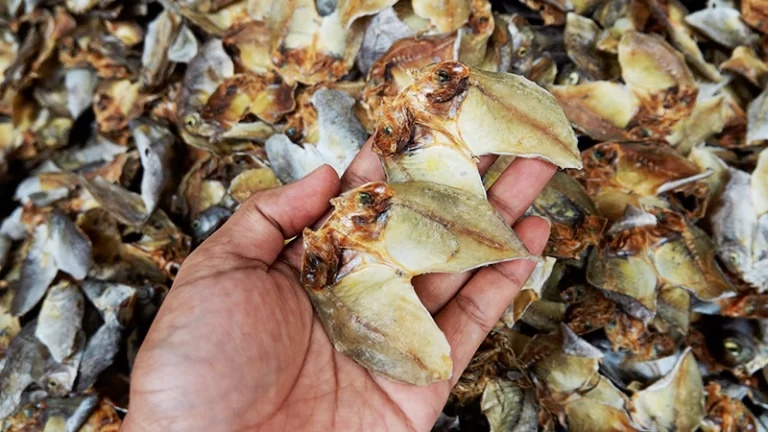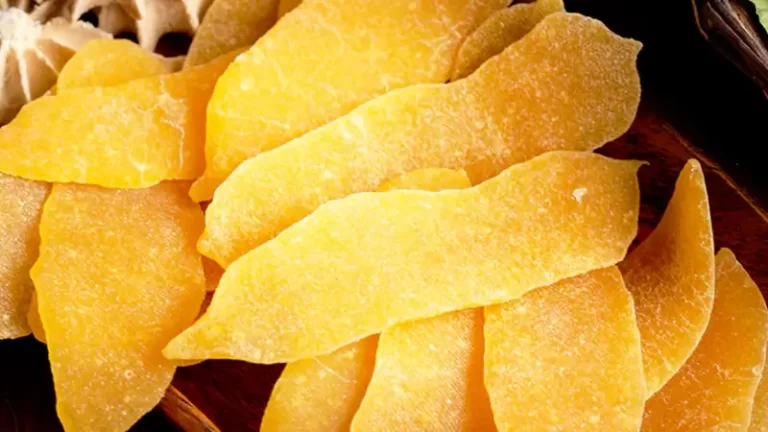Squid, or locally known as pusit, is one of the world’s most popular seafood. Like any seafood, squid is versatile and can be boiled, seared, braised, grilled, and dried.
In Asian countries like Korea, Japan, China, and the Philippines, dried squid is a popular choice not only for its flavor but also for its affordability.
What is Dried Pusit?
Dried squid, popularly known as dried pusit, is a salted and sun-dried seafood product commonly produced in the Philippines.
What is Danggit and Pusit?
Danggit and pusit are two very different food items. The spine foot fish (known sometimes as rabbitfish, the family to which it belongs) is called danggit in the local language.
The danggit must be cleaned just after it is fished, after which it is deboned – leaving the two filets joined – so as to get it ready to be processed. Learn more about danggit here.
On the other hand, dried pusit is made from cleaned fresh squids which are then sun-dried.
Another variation, the dried shredded squid, is a dried, shredded, and seasoned seafood product. Both are made from squid.
Dried Pusit Origin
Historically, squid is common in Pacific coastal regions of East Asia and Southeast Asia.
After the packaged form began shipping to English-speaking regions, the Japanese word surume and yóu yú sī in Chinese for this form of seafood was translated as “dried shredded squid” and imprinted on packages.
The snack was popularized, sold, and consumed regularly in Hong Kong during the 1970s. Shredded squid began being sold in Macau as an addition to their almond biscuit.
In China, it is usually considered to be a light snack, sold in bags in many department stores in major cities.
In Japan, dried shredded squid is popularly served as an otsumami (snack consumed while drinking alcohol).
In Korean cuisine, dried shredded squid is eaten as anju (food to eat while drinking) and as banchan (small side dishes), such as the dish ojingeochae bokkeum, which is made by stir-frying dried shredded squid seasoned with a mixture of gochujang (chili pepper paste), garlic, and mullyeot (corn syrup-like condiment).
In Singapore, it was also popular amongst the older generation when it was sold in a Mama shop.
It was marketed as the Chewing gum of the Orientals by the food manufacturing company Ken Ken in the 1970s, before the chewing gum ban in Singapore in 1992.
Dried Squid Nutrition Facts
Curious about dried pusit calories and other nutrition facts? According to EatThisMuch, 28g of dried squid contains:
- 180 Calories
- 30g Carbs (30g net carbs)
- 1g Fat
- 14g Protein
| Nutrition Facts | |
| For a Serving Size of 28 g (28g) | |
| Calories 180 | Calories from Fat 9 (5%) |
| % Daily Value * | |
| Total Fat 1g | – |
| Cholesterol 90mg | – |
| Sodium 700mg | 30% |
| Carbohydrates 30g | – |
| Net carbs 30g | – |
| Sugar 2g | – |
| Fiber 0g | 0% |
| Protein 14g | |
| Vitamins and minerals | |
| Vitamin A 0μg | 0% |
| Vitamin C 1.2mg | 3% |
| Calcium 20mg | 3% |
| Iron 0.4mg | 5% |
| Fatty acids | |
| Amino acids |
*The Percent Daily Values are based on a 2,000-calorie diet, so your values may change depending on your calorie needs.
How is Dried Squid Made?
Sun-drying is the most common method of making dried squid. You simply have to wash the squid thoroughly and split and remove internal organs.
Then, spread the washed squid meat on drying trays, pat dry with a paper towel, and dry under the sun. Always remember to turn it over once or twice to keep the dryness consistent.
Alternatively, you can use a dehydrator to make the process easier and faster.
Before dehydrating, remember to blanch the squid in a large pot of boiling water and shake it dry.
Then, put it in the dehydrator at low to medium heat, around 70-90 C. This method might make your dried squid very chewy and not tender.
After drying the squid, make sure to pack it in a plastic bag and store it in a cool and dry place.
Dried products can last for months and sometimes even years.
Dried squid processing
Here’s a quick step-by-step guide:
- Sort out the squid according to size (small, medium, and large) small size ranges from 25-30 cm long, medium size ranges from 31-35 cm, and large from 36-40 cm.
- Manually clean the squid thoroughly by removing the eyes, skin, mouth, and fins using salt or tap water.
- Slit open the underneath portion of the squid entrails.
- Sundry cleaned squid inside out from 8:00 am to 3:00 pm using a dryer made a bamboo mat known as capping.
- Collect the sun-dried then air-dry for an hour under the shade.
- Sun-dry the squid again from 4:00 pm to 5:00 pm.
- Collect the squid late in the afternoon when the temperature is low to prevent the squid from sticking to the dryer.
- Sun-dry squids the following day, this time outside out.
- Flatten the body and tentacles of the squid by spreading some oil and rolling a bottle over it.
- Weigh the squid and pack by the kilogram.
- Lay flat inside a prepared box ready for transport.
Processing of dried squid
Other methods:
- Preparation. Fresh squid is cut longitudinally in the center of the abdomen. The head is cut in the center and the organs and eyes are removed. The fins, skin, soft shell, and beak remain.
- Washing. The prepared squid is first washed in seawater to remove contaminants, which adhere, and it is then washed in fresh water to remove the salt.
- Drying-shaping. There are various drying methods, including suspension drying and skewer drying, but hanging drying is usually employed. Ropes are stretched and the prepared, washed squid are hung in places with good exposure to sunlight. The arms are separated and extended to facilitate drying. The squid is left on the ropes at night since air circulation is good even then.
- The squid is removed from the rope the next day, extended, and shaped. The squid is then spread on a straw mat with their backs upward, and they are dried in the sun. They are inverted during drying to continue the process and packed in boxes with a plastic layer at night. The next day, they are removed and again extended and shaped. They are stretched on straw mats until sufficiently dried.
Types of Dried Pusit
Did you know that there are many different types of dried squid? In the Philippines, there are also “specialty” dried pusit you can buy, such as Cebu Dried Pusit and Bantayan Dried Pusit which is famous for its sweet taste.
There are multiple variants for this product, but some of the most popular include:
Whole Dried Squid

Shredded Dried Squid

Dried pusit be sold shredded in thin strands for more convenience or sold whole so you can try the textures of different parts of the squid (tentacles, body, etc.).
The product is usually roasted to impair more flavors. The more processed versions (usually shredded) are seasoned with sugar, salt, and spices differently from the less processed ones in which seasoning is not added.
What Does Dried Squid Taste Like Is Dried Squid Tasty?
The taste of dried squid varies depending on how it was processed, produced, and flavored. For example, some dried squid may taste sweet (sweet dried pusit), others salty and spicy.
Texture-wise, most dried squid can have a chewy texture, while some may feel extra dry and tender.
Dried Squid can also be combined with other dishes to create a different flavor.
The drying process enhances the flavor of the squid, making it heavenly in strengthening the flavor of dishes.
How Do You Make Dried Pusit Crispy?
If you prefer crispy dried pusit, fry it!
- Soak dried squid in water for 30 minutes to soften before frying. Dry thoroughly with a paper towel before cooking.
- Heat oil over medium-low heat.
- Place sweet dried pusit and lower heat to low.
- Slow cook each side for 3 minutes. Use the kitchen utensil to flatten the squid. If you don’t do this it will curl and will not cook evenly.
- Before removing from the pan adjust the heat to medium. Cook for another minute to crispy the dried squid.
- Transfer to a plate lined with a paper towel. Let it rest for a few minutes and it will get crispier.
- Serve with vinegar dip or any pickled vegetable.
- Enjoy!
Bonus Tips:
- Don’t put it on very high heat, it will overcook and taste burnt.
- Once you open the package any uncooked squid can go back to the freezer. You can store it for months in an airtight container or zip lock.
- If the dried product is too salty or tough, submerge it in water for ½ hour before frying.
- Yes, dried products can be grilled or cooked in the oven.
Dried Pusit Recipes
Aside from simply frying it, there are many things you can do with dried pusit. Here are some recipes you can try!
👩🏻🍳 Dried Squid (in the Oven)
Did you know that you can cook dried squid in the oven? Try this simple recipe at home!
Ingredients:
- Frozen squid – 1-2 kg
- Sugar – 1 tbsp (to taste)
- Freshly ground black pepper – 1/2 teaspoon (to taste)
- Ground paprika – 1 teaspoon (to taste)
- Dry garlic – 1 teaspoon (to taste)
- For brine:
- Water – 1 l
- Salt – 150-200 g
Instructions:
- When buying frozen squid, you need to take into account the water content and shrinkage during cooking by about 2.5 times. Squids need to be thawed (preferably in the refrigerator), rinsed, peeled from the skin, and the chitinous plate and entrails removed. Tip: Squids are better cleaned if the carcasses are thrown into hot water for 2-3 seconds (80 degrees). Then the skin will curl up and peel off well. After that, all that remains is to rinse the squid.
- For salting squid, heat the water a little (up to about 50 degrees) so that the salt dissolves faster. Add salt. Send the prepared carcasses to the brine for 2-3 minutes, depending on the size of the squid. If the carcasses are small, two minutes will be enough.
- Dry the salted squid a little from water and cut it as you like.
- If you want to get dried shavings, then the squid will need to be dried whole.
- Mix “taste” (spices) on a plate and send to the chopped squid. Mix everything well. You can use any spices you like.
- Layout the squid on a baking sheet covered with parchment paper. Put it in the oven to dry at 50-70 degrees (you don’t need to check it) for 4 hours. You can also dry the squid in a dryer (I won’t tell you exactly in time), or the whole carcasses can be dried on a “rope”, like a vobla.
- The dried squids are ready. From 600g of prepared thawed squid, you can get around 230g of dried ones.
- Make a snack of 2 kg squid right away, as they are eaten quickly.
👩🏻🍳 Fried Dried Squid
If you’ve never tasted it before, it kind of tastes like beef jerky but it has its own pungent smell, intense flavor, and unique texture. It’s a little hard, but when you chew it, it gets soft with a lot of savory flavors.
Frying the squid twice is essential. Just like fried chicken, it might look crispy when fried once, but in a few minutes, it will become soggy. Frying it a second time will keep it crispy for much longer. For convenience, you can fry some extra squid just once, freeze it, and then fry it again right before serving.
Ingredients:
- 1 large dried squid (about 4 ounces)
- ⅓ cup potato starch
- ¼ cup plus 2 tablespoons all-purpose flour
- pinch baking powder
- ¼ teaspoon kosher salt
- 1 egg
- ⅓ cup reserved squid-soaked water
- 4 to 5 cups vegetable oil
For soy sauce vinegar dipping sauce:
- 2 tablespoons soy sauce
- 1 tablespoon white vinegar
- ¼ teaspoon hot pepper flakes (optional)
- ½ teaspoon sesame seeds
Instructions:
- Prepare squid
- Separate the arms and body of the squid. Remove the bone that looks like plastic inside the squid. Use scissors to cut the body of the squid crosswise into ½-inch-wide pieces. Separate the arms into pieces with the scissors. Soak in 2 to 3 cups of cold water for 4 to 5 hours until soft and flexible.
- Drain and pat dry with paper towels. Reserve the water from soaking.
- Mix the squid with 2 tablespoons flour with your hands to coat evenly. Set aside.
- Fry
- Combine potato starch, the remaining ¼ cup flour, kosher salt, baking powder, egg, and the reserved squid-soaking water in a mixing bowl. Mix well with a fork.
- Heat the vegetable oil in a 10 to 12-inch pan over medium-high heat until it reaches 350 F. Drop a small spoonful of batter into the heated oil. If the batter floats to the surface in a second, the oil is hot enough for cooking.
- Dip each piece of squid into the batter to coat well. Carefully place the coated squid pieces, a few at a time, into the hot oil. Cook, turning a few times, until the batter is lightly golden and crunchy, about 1 to 2 minutes total. Transfer the cooked squid to a strainer. Repeat with the remaining squid pieces.
- When the squid pieces have all been fried once, fry them again, for 3 to 4 minutes until very crunchy and golden brown. Drain on a paper towel-lined plate.
- Serve
- Make a soy vinegar dipping sauce by combining soy sauce, vinegar, hot pepper flakes (if used), and sesame seeds in a small bowl and mixing it well.
- Serve immediately, with the sauce.
Looking for more dried pusit recipes? Check out our blog article here!
Dried Pusit Price Per Kilo
Prices for dried pusit vary and dried pusit price per kilo in 2021, dried pusit price per kilo in 2022, and dried pusit price per kilo in 2023 are all different.
Currently, the dried pusit price per kilo is around Php 1,200 – Php 1,700. Please note that prices can vary depending on where you buy them.
Where to Buy Dried Pusit
You can buy pre-packaged dried pusit from most grocery stores and markets nationwide.
If you’re in Cebu, you can buy fresh and unpackaged Cebu dried pusit from local markets, particularly at Cebu Taboan Market, where you’ll find rows of baskets filled with dried squid.
You can also buy dried pusit online! With just a few clicks, you can have dried pusit delivered straight to your home. You can order dried pusit online from BigBuyMall.ph, Shopee, and Lazada.
Sources:
https://en.wikipedia.org/wiki/Dried_shredded_squid
https://www.eatthismuch.com/food/nutrition/dried-squid,2176951/













